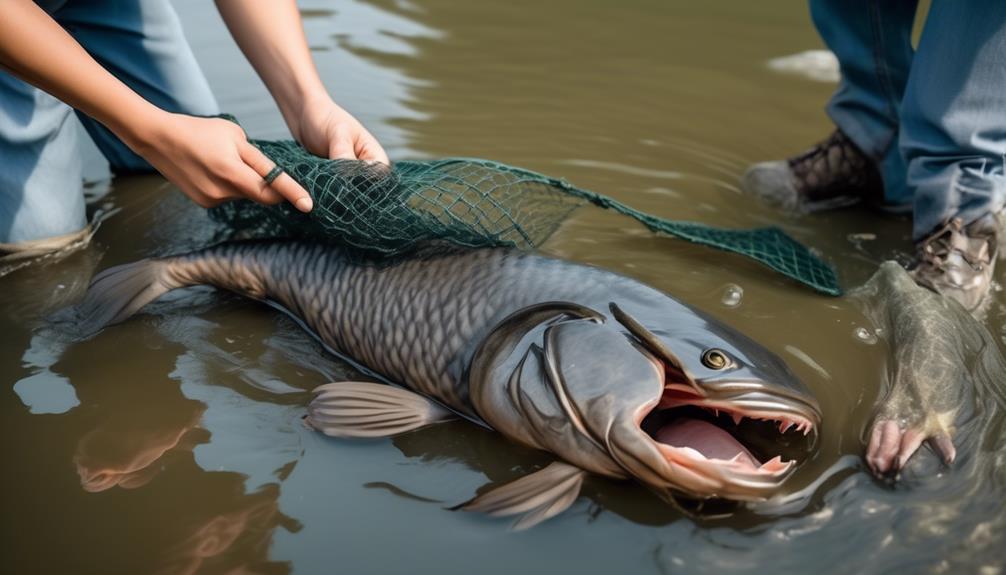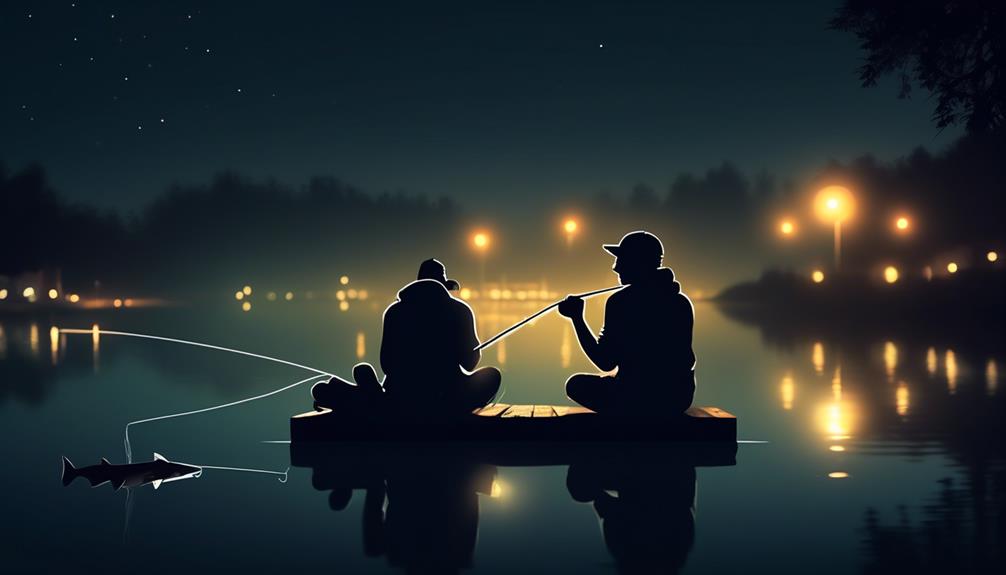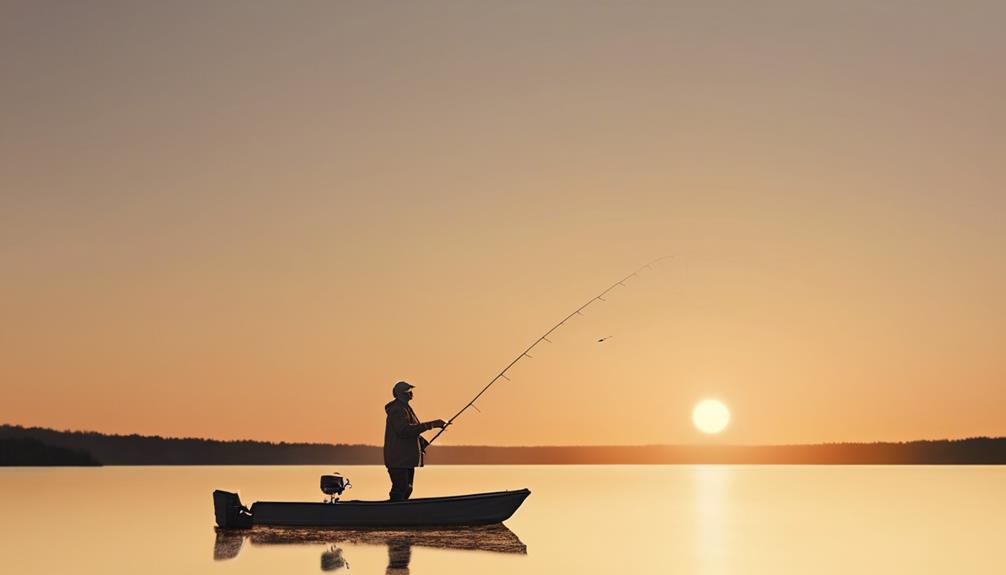So, you've heard that catching catfish at night is a breeze, right? Well, it's not exactly a walk in the park, but with the right techniques, you can significantly improve your chances of reeling in a hefty catch.
From setting up your gear to mastering the art of the slip sinker rig, there are several key strategies that can make all the difference.
But let's not get ahead of ourselves – first, let's talk about setting up the right equipment to kickstart your night fishing adventure.
Setting Up the Right Equipment
Ensure you have the right equipment for night fishing by equipping yourself with a reliable headlamp, a sturdy rod and reel, and strong, abrasion-resistant fishing line. When it comes to rod selection, opt for a medium to heavy rod with a fast action tip to help you feel the subtle bites in the dark. Pair this with a reel that has a smooth drag system and can handle heavier lines. Speaking of line strength, it's crucial to use at least 20-pound test line to handle the large catfish you'll encounter at night.
Proper rigging and tackle setup are vital for successful night fishing. Start by attaching a sliding sinker to the main line, followed by a swivel to prevent line twists. Then, tie on a leader line with a strong and sharp circle hook. Utilize a slip bobber to keep your bait off the bottom and in the strike zone. Incorporating glow-in-the-dark beads or a lighted bobber can also help you track your line in the darkness. Additionally, consider using scented bait to attract catfish by their keen sense of smell in low light conditions.
Choosing the Best Bait
To attract catfish during night fishing, your choice of bait is crucial for enticing bites and maximizing your chances of a successful catch. When it comes to catfish, there are several best bait options that are known to be effective.
One of the most popular baits for catfish is chicken liver. It has a strong odor that can attract catfish from a distance. To use chicken liver effectively, consider using a treble hook to keep it secure while casting.
Another effective bait option is live bait such as nightcrawlers or minnows. These baits have natural movement in the water, which can be very appealing to catfish. When using live bait, it's important to present it in a way that allows it to move naturally. This can be achieved by using a slip sinker rig, which allows the bait to move freely in the water.
Additionally, stink baits are also popular for catfish. These baits are specially designed to release strong scents that can attract catfish. When using stink baits, consider using a dip bait holder to keep the bait secure and prevent it from easily washing off.
Ultimately, the key to choosing the best bait is to consider the natural prey of catfish in the area you're fishing, and to present the bait in a way that appears natural and enticing. By experimenting with different bait options and bait presentation techniques, you can find the most effective approach for enticing catfish during night fishing.
Locating Prime Fishing Spots
When night fishing for catfish, pinpointing prime fishing spots is essential for maximizing your chances of a successful catch. Understanding catfish behavior is crucial when trying to locate the best fishing spots. Catfish are known to be bottom feeders, so look for areas with underwater structures such as fallen trees, rocks, or deep holes where catfish are likely to hide during the day and feed at night. These structures provide catfish with shelter and ambush points, making them ideal spots for nighttime fishing.
Another key factor in locating prime fishing spots for night fishing is ensuring nighttime fishing safety. When scouting for fishing spots, be cautious of your surroundings and choose areas that are safe and accessible in the dark. Avoid fishing near swift currents or in areas with dense vegetation that can make it difficult to navigate. It's also important to inform someone about your fishing plans and location, especially when fishing alone at night, for added safety.
In addition to understanding catfish behavior and ensuring nighttime fishing safety, consider the water temperature and oxygen levels. Catfish are more active in warmer waters, so look for spots where the water temperature is slightly higher. Oxygen-rich areas, such as inlets or areas with flowing water, are also prime spots for catfish feeding at night.
Mastering the Slip Sinker Rig
After pinpointing prime fishing spots based on catfish behavior and safety considerations, mastering the slip sinker rig is the next crucial step for maximizing your night fishing success. The slip sinker rig is a popular choice for targeting catfish in various water bodies. Here's how you can effectively use this rig to improve your chances of a successful night fishing excursion:
- Weight Distribution: The slip sinker rig allows for precise weight distribution, ensuring your bait reaches the desired depth where catfish are actively feeding. By adjusting the weight of the sinker based on the water's current and depth, you can present your bait in the strike zone, increasing the likelihood of attracting catfish.
- Bait Presentation: One of the key advantages of the slip sinker rig is its ability to present live or natural baits in a natural manner. The sliding nature of the weight enables your bait to move freely, mimicking the natural movement of prey. This lifelike presentation entices catfish to strike, leading to more successful hook-ups.
- Sensitivity and Hook Setting: With the slip sinker rig, you can maintain a high level of sensitivity, allowing you to detect subtle bites from catfish. Once you feel a bite, the sliding weight allows the catfish to take the bait without immediately feeling the resistance of the weight, giving you time to set the hook effectively.
- Reduced Snagging: The design of the slip sinker rig minimizes the chances of your line getting tangled or snagged in underwater structures, making it an excellent choice for navigating through catfish habitats without constant concern for losing your rig.
Mastering the slip sinker rig is a fundamental skill that can significantly enhance your night fishing experience for catfish.
Utilizing Effective Night Lights
For maximizing your night fishing success, employing effective night lights is essential to attract catfish and improve visibility in the dark waters.
When selecting night lights for catfishing, consider the light color and intensity to optimize your chances of a successful fishing trip.
Firstly, the color of the light plays a crucial role in attracting catfish. Blue and green lights are popular choices for night fishing as they penetrate the water better and are more visible to catfish. These colors stand out in the darkness, drawing in catfish from a distance. Additionally, these colors have been found to attract more baitfish, which, in turn, lures in the catfish. Therefore, using blue or green lights can significantly enhance your chances of a successful catch.
In addition to the color, the intensity of the light is equally important. Bright lights are effective at attracting catfish and increasing visibility in the water, allowing you to see any potential activity around your bait. However, it's essential to strike a balance, as excessively bright lights can also scare away catfish. Finding the right intensity level is key to maximizing the effectiveness of your night lights without disturbing the catfish.
Perfecting the Scent Trail
To enhance your night fishing success further, focus on perfecting the scent trail to attract catfish to your bait, building on the effective use of night lights. Creating a strong scent trail is essential for luring catfish in the darkness. Here's how you can perfect the scent trail to improve your chances of a successful night fishing trip:
- Scent Dispersion: Ensure that the scent from your bait disperses effectively in the water. To achieve this, consider using bait with a strong odor that can spread through the water, attracting catfish from a distance. Additionally, using bait containers or cages that slowly release scent into the water can help create a more potent and long-lasting scent trail.
- Bait Selection: Opt for baits that aren't only visually appealing but also have a powerful scent. Catfish have a strong sense of smell, so using baits such as chicken liver, cut bait, or natural bait like nightcrawlers can significantly enhance the scent trail, increasing the likelihood of attracting catfish to your fishing spot.
- Wind and Water Currents: Take into account the direction of the wind and water currents when positioning your bait. Placing your bait in an area where the wind or currents can carry the scent downstream or across the water can help maximize the reach of your scent trail, increasing the chances of catfish detecting and locating your bait.
- Scent Refreshment: Regularly refresh the scent trail by adding fresh bait or applying scent attractants to your bait. This practice ensures that the scent remains potent and continues to lure catfish to your fishing area throughout the night.
Handling the Catch With Care

Handle the caught catfish with care to ensure its safe and healthy release back into the water. Fish preservation is crucial in maintaining the well-being of the catfish population and the overall ecosystem. When you land a catfish, avoid causing unnecessary harm by handling it gently. Use wet hands or a wet cloth to hold the fish, as this helps protect its protective slime layer, which is essential for its health. Avoid squeezing the fish tightly or dropping it on hard surfaces.
Ethical angling practices also play a significant role in handling the catch with care. Always use appropriate and strong enough tackle to minimize the time it takes to land the catfish. The longer the fight, the more exhausted the fish becomes, making its recovery after release more challenging. When unhooking the catfish, do it quickly and efficiently, using proper tools such as long-nose pliers to minimize handling time. If the fish is deeply hooked, consider cutting the line close to the hook instead of trying to remove it, as this reduces the risk of causing internal injuries.
Furthermore, support the catfish properly when lifting it out of the water for a quick photo before releasing it. Gently cradle the fish under its belly and support its weight to avoid harming its internal organs.
Maximizing Success With Patience
With a patient approach, you can maximize your success in night fishing for catfish. Patience is key when it comes to reeling in those elusive catfish, and by incorporating time management and a strategic fishing approach, you can significantly increase your chances of a successful catch.
Here are some tips to help you make the most of your night fishing experience:
- Time Management: Plan your night fishing trip strategically by considering the best times for catfish activity. Catfish are known to be more active during the evening and early morning hours. By scheduling your fishing expedition during these peak times, you can improve your chances of a successful catch.
- Fishing Strategy: Take the time to analyze the weather conditions and understand how they can impact fish behavior. Catfish tend to be more active when the weather is stable, and they may retreat to deeper waters during extreme temperature changes. By adjusting your fishing strategy based on the weather, you can optimize your chances of attracting catfish to your bait.
- Be Patient and Persistent: Night fishing for catfish requires patience and persistence. It may take some time for the catfish to detect your bait and decide to strike. Avoid frequently changing your fishing spot or bait as soon as you cast your line. Give it some time and allow the catfish to respond to your bait.
- Stay Alert and Attentive: While patience is crucial, it's also important to stay alert and attentive. Keep a close eye on your fishing rod for any subtle movements that could indicate a catfish has taken the bait. Being attentive and ready to react promptly can significantly improve your chances of a successful catch.
Frequently Asked Questions
How Can I Ensure the Safety of Myself and Others While Night Fishing for Catfish?
To ensure safety while night fishing for catfish, prioritize safety precautions and emergency preparedness. Use appropriate night fishing gear and consider various lighting options for visibility. Always be aware of your surroundings and have a plan in case of emergencies.
Are There Any Specific Regulations or Guidelines I Need to Be Aware of When Night Fishing for Catfish?
When night fishing for catfish, it's important to be aware of specific regulations and guidelines in your area. Take necessary safety precautions, follow night fishing etiquette, and be mindful of the environmental impact.
What Are Some Common Mistakes to Avoid When Night Fishing for Catfish?
When night fishing for catfish, avoid common mistakes like not properly preparing your gear and underestimating the importance of a good light source. Take time to prepare and ensure you have the right equipment.
How Can I Effectively Handle and Release Catfish to Ensure Their Survival?
When handling catfish, use wet hands or a rubberized glove to protect their slime coat. Support their body properly and avoid squeezing. To release, gently place them back in the water, supporting until they swim away on their own.
Are There Any Additional Tips for Maximizing Success When Night Fishing for Catfish?
To maximize success when night fishing for catfish, understand their behavior and use the right bait. Catfish are more active at night and tend to stay near the bottom. Using smelly baits like chicken liver or stink bait can attract them.
Conclusion
Now that you have mastered the top night fishing techniques for catfish, it's time to get out there and put your skills to the test.
Remember to:
- Set up the right equipment
- Choose the best bait
- Locate prime fishing spots
- Use the slip sinker rig
- Utilize effective night lights
- Perfect the scent trail
- Handle the catch with care
- Most importantly, be patient.
With these techniques in your arsenal, you'll be sure to have a successful night of catfishing.



